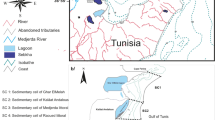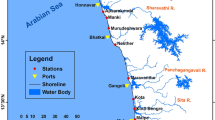Abstract
The coastal zones management not only relies on a profound knowledge of the shoreline but also on a good assessment of morphodynamics, sediments transport and coastal interventions required. Many coastal studies, such as beach slope estimates, equilibrium beach profile definition or sediment transport analysis, depend on the sediment grain size at the site. This paper aims to gain a better understanding of grain size distribution along the cross-shore profile and variation of d50, allowing to define a representative d50 to characterize the beaches. On the study site chosen, Barra beach, Aveiro, an extensive field campaign was performed, from October 2010 to May 2011. In a weekly basis, samples from 5 points along a cross-shore profile were collected. During this period, data related to wave climate was collected from the Portuguese Hydrographic Institute in temporal series of 10 min. Tidal projections from Hydrographic Institute were also identified for the period of the field campaigns. The sediment grain size distributions showed that, although the mass-median-diameter does not usually pass the 1 mm, d50 presented a great variation during winter, in the intertidal zone. On the other side, the first and last points of the cross-shore profile, located far from the intertidal zone, presented the smaller d50 and variation through time. The significant wave height presented a mean value of 2.16 m. The most energetic wave climates happened in November, January and February. During those months, an increase of d50 in the wave breaking zone was noticed. Generally, the expected behavior of the cross-shore sediment grain size distribution is in line with the data collected in this paper and it was verified that the grain size is coarser on the intertidal zone and after storm periods. Also, despite the complexity of defining a characteristic d50 due to its great temporal and spatial variation, sensitivity analysis on the data obtained helped the identification of the upper foreshore limit, at high tide, as the better location for a sediment sample collection representative of a cross-shore profile.














Similar content being viewed by others
References
Andrade C, Freitas M (2001) Coastal zones. In: Santos F, Forbes K, Moita R (eds) Climate change in Portugal, scenarios, impacts and adaptation measures - SIAM. Gradiva, Lisbon, pp 175–215
Bettencourt P (1997) Notas para uma estratégia de gestão da orla costeira. Colectânea de ideias sobre a Zona Costeira de Portugal:265–283
Blott S, Pye K (2001) GRADISTAT: a grain size distribution and statistics package for the analysis of unconsolidated sediments. Earth Surf Process Landf 26:1237–1248. doi:10.1002/esp.261
Celikoğlu Y, Yüksel Y, Sedat Kabdaşlı M (2004) Longshore sorting on a beach under wave action. Ocean Eng 31:1351–1375. doi:10.1016/j.oceaneng.2004.02.001
Celikoğlu Y, Yüksel Y, Sedat Kabdaşli M (2006) Cross-shore sorting on a beach under wave action. J Coast Res 22:487–501. doi:10.2112/05-0567.1
Coelho C (2005) Riscos de exposição de frentes urbanas para diferentes intervenções de defesa costeira. Ph.D. Thesis, University of Aveiro
Coelho C, Conceição T, Ribeiro B (2009) Coastal erosion due to anthropogenic impacts on sediment transport in Douro river-Portugal. In: Proceedings of Coastal Dynamics, Tokyo. World Scientific, p 15
Coelho C, Lopes D, Freitas P (2009) Morphodynamics classification of Areão Beach, Portugal, Journal of Coastal Research, SI 56 (Proceedings of the 10th International Coastal Symposium), 34–38. Lisbon, Portugal. http://www.cerf-jcr.org/index.php/international-coastal-symposium/ics-2009portugal/592-morphodynamics-classification-of-areao-beach-portugal-c-coelho-d-lopes-and-p-freitas
Collet I, Engelbert A (2013) Coastal regions: people living along the coastline, integration of NUTS 2010 and latest population grid. vol 30. EUROSTAT
Costa M, Silva R, Vitorino J (2001) Contribuição para o estudo do clima de agitação marítima na costa portuguesa. In: 2as Jornadas Portuguesas de Engenharia Costeira, Sines. Associação Internacional de Navegação, p 20
Dean R (1977) Equilibrium beach profiles: US atlantic and gulf coasts. Department of civil engineering and college of marine studies. University of Delaware, Delaware
Dias J (2005) Evolução da zona costeira portuguesa: forçamentos antrópicos e naturais. Tour Manag Stud 1:7–27
Ferreira Ó (1993) Caracterização dos principais factores condicionantes do balanço sedimentar e da evolução da linha de costa entre Aveiro eo Cabo Mondego. MSc Thesis, University of Aveiro
Fonseca J (2011) A dimensão dos sedimentos na caracterização das praias. MSc Thesis, University of Aveiro
Guillén J, Hoekstra P (1997) Sediment distribution in the nearshore zone: grain size evolution in response to shoreface nourishment (island of terschelling, The Netherlands). Estuar Coast Shelf Sci 45:639–652. doi:10.1006/ecss.1996.0218
Hanson H, Kraus N (1989) GENESIS: generalized model for simulating shoreline change. U.S. Army Corps of Engineers
Hassan W (2003) Transport of size-graded and uniform sediment under oscillatory sheet-flow conditions. Ph.D. Thesis, University of Twente
IH (2011) Instituto Hidrográfico. www.hidrografico.pt. Accessed 11/07/2014
Kamphuis J (1991) Alongshore sediment transport rate. J Waterw Port Coast Ocean Eng 117:624–640. doi:10.1061/(ASCE)0733-950X(1991)117:6(624)
Kamphuis J (2000) Introduction to coastal engineering and management, vol 16. World Scientific, Singapore. doi:10.1142/9789812386403_fmatter
Lopes J, Dias J, Dekeyser I (2001) Influence of tides and river inputs on suspended sediment transport in the Ria de Aveiro lagoon, Portugal. Phys Chem Earth Part B: Hydrol Oceans Atmos 26:729–734. doi:10.1016/S1464-1917(01)00077-0
Masselink G (1992) Longshore variation of grain-size distribution along the coast of Rhode Delta, Southern France - A test of the McLaren Model. J Coast Res 8:286–291
McCave I (1978) Grain-size trends and transport along beaches: example from eastern england. Mar Geol 28:43–51. doi:10.1016/0025-3227(78)90092-0
Pereira L (2000) Evolução de curto prazo da linha de costa entre Costa Nova e Poço da Cruz. Aveiro. MSc Thesis, University of Aveiro
Short A (1999) Handbook of beach and shoreface morphodynamics. Wiley, Australia. doi:10.1002/1099-0755(200009/10)10:5<391::AID-AQC418>3.0.CO;2-F
Silva R, Coelho C, Veloso-Gomes F, Taveira-Pinto F (2007) Dynamic numerical simulation of medium-term coastal evolution of the west coast of portugal. J Coast Res 50:263–267
Silva R, Baptista P, Veloso-Gomes F, Coelho C, Taveira-Pinto F (2009) Sediment grain size variation on a coastal stretch facing the north atlantic (NW Portugal). J Coast Res 56:762–766
Sunamura T (1984) Quantitative predictions of beach-face slopes. Geol Soc Am Bull 95:242–245. doi:10.1130/0016-7606(1984)95<242:QPOBS>2.0.CO;2
Terwindt J (1962) Study of grain size variations at the coast of Katwijk. Note K-324. Rijkswaterstaat, Deltadienst, Den Haag, The Netherlands
Trigo-Teixeira A, Matos J, Pimentel C, Pinheiro J (2000) A map of land at risk on the Portuguese Coast. Period Biol 102:605–612
Veloso-Gomes F, Taveira-Pinto F, das Neves L, Pais Barbosa J, Coelho C (2004) Erosion risk levels at the NW Portuguese coast: the Douro mouth—Cape Mondego stretch. J Coast Conserv 10:43–52. doi:10.1652/1400-0350(2004)010[0043:ERLATN]2.0.CO;2
Visher G (1969) Grain size distributions and depositional processes. J Sediment Petrol 39:1074–1106. doi:10.1306/74D71D9D-2B21-11D7-8648000102C1865D
Wang P, Davis R, Kraus N (1998) Cross-shore distribution of sediment texture under breaking waves along low-wave-energy coasts. J Sediment Res 68:497–506
Acknowledgments
This work was supported by FCT (Fundação para a Ciência e Tecnologia) in the framework of the doctoral programme Infrarisk - Analysis and Mitigation of Risks in Infrastructures with the theme Coastal Erosion Risk Assessment at Portuguese Speaking Countries (PD/BI/52577/2014).
Author information
Authors and Affiliations
Corresponding author
Rights and permissions
About this article
Cite this article
Narra, P., Coelho, C. & Fonseca, J. Sediment grain size variation along a cross-shore profile – representative d50 . J Coast Conserv 19, 307–320 (2015). https://doi.org/10.1007/s11852-015-0392-x
Received:
Revised:
Accepted:
Published:
Issue Date:
DOI: https://doi.org/10.1007/s11852-015-0392-x




